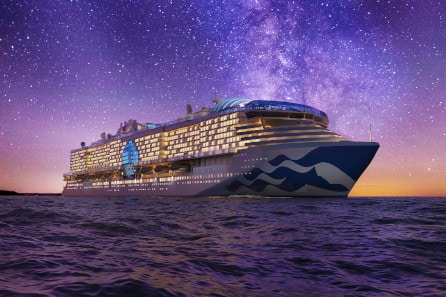Best time to cruise Alaska for whale sightings
A majestic whale breaches the surface of the water at Alaska's Inside Passage near Juneau.
- The bright time is the right time to see whales
- May through September is the best time to see humpback whales in Alaska
- Spring and summer are the best times to see orcas (killer whales) in Alaska
- July and August are the best times to see beluga whales in Alaska
- April through June is the best time to see gray whales in Alaska
- Summer is the best time to see blue whales in Alaska
- Will you see whales from your cruise ship?
- Why whales migrate to Alaska
- About the Author
Why take a Princess Cruise® along the Alaska coastline? The opportunity to experience Alaska’s rich cultural history, enjoy delicious cuisine and see jaw-dropping scenery — while enjoying the unmatched luxury of a Princess cruise ship — are all great answers. But the real showstopper of a cruise into the waters of Alaska’s Inside Passage is the chance to see whales up close in their natural habitat. Imagine seeing a humpback breach the surface as you stand on deck or spotting a pod of orcas slicing through the water. The thrill of witnessing these majestic creatures is something you won’t soon forget.
The grandeur of encountering whales is something that has to be experienced to be understood and it’s one of the many reasons an Alaska cruise with Princess should be on your bucket list. And, while it’s possible to catch sight of these gentle giants from the deck of your cruise ship (or even from the balcony or window of your stateroom), your best bet for a close encounter of the whale kind is to book a whale-watching excursion with Princess. Whale-watching vessels have the ability to approach as close as 100 yards to a humpback whale — a distance that hardly requires binoculars to get a good look at one of the biggest animals nature has to offer. That said, whales aren’t always in the mood to put on a show; they tend to be more visible and more active at certain times and under specific conditions. So, let’s explore the best time to see whales during your Princess Alaska cruise.
The bright time is the right time to see whales
Most travelers enjoy long days, warm sunshine and pleasant weather — and so do aquatic mammals. This makes spring and summer the best times to cruise Alaska for whales. Most species of whales are active from April through September, engaging in behaviors like breaching, feeding and playing (and maybe even showing off a new baby or two). Summer cruises in Alaska provide the perfect opportunity to see these animals when they’re most ready to make an entrance. Oh and don’t worry about there not being enough hours in the day: Summer in Alaska means sunlight well into the evenings, giving you more chances to see it all. From post-worthy landscapes and sightings of everything from moose to migrating humpbacks, there’s no better way to get the most out of your day.
Looking for a specific type of whale? Whether you’ve always been fascinated by a specific species or you're just going for blackout in a game of whale bingo, it’s important to note that each type of whale has its own migration patterns. We've rounded up a list of the best times to see individual species — consider what's most important to you on your aquatic adventure so you can plan your Princess Alaska whale-watching cruise accordingly.
May through September is the best time to see humpback whales in Alaska
PrincessCruises may have fine dining and delectable dishes to suit any taste, but when it comes to eating, it’s just not possible to outpace a humpback. From May to September, humpback whales make their way to Alaska, where they indulge in an all-they-can-eat seafood buffet of krill, herring and bait fish — chowing down up to 1.5 tons every day. For a front-row seat to the biggest fish feast in the North, hop on a Juneau whale-watching excursion from May through September, when whale action is at its peak.
Spring and summer are the best times to see orcas (killer whales) in Alaska
Orcas, famously known as killer whales, are the ocean’s apex predators and make thrilling appearances in Alaska’s waters. These sleek black-and-white giants travel in groups, creating unforgettable spectacles for lucky sightseers. Orcas like to keep on the move, migrating northward through the Bering Strait as the pack ice retreats in spring. You might catch them hunting in the cooler coastal waters of Southeast Alaska, Prince William Sound and even up to the Aleutian Islands. When the ice begins to advance again in the fall, they head south, hounding their prey in a globe-spanning chase that feels more like an epic adventure than a migration.
These “sea wolves” hunt in coordinated pods, showing off astonishing intelligence and teamwork. How do they make it happen? Each pod has its own unique language — a series of clicks, whistles and calls that lets them communicate as they navigate the icy waters (gives a whole new meaning to the term “podcast”). Orcas are truly the kings and queens of the sea, reaching lengths of around 27 feet, sporting dorsal fins up to 6 feet tall and weighing up to 13,300 pounds (that's about 13 times heavier than a grand piano). Whether they’re breaching, hunting or simply gliding through the water, these beautiful creatures never fail to leave a lasting impression on anyone lucky enough to see them.
July and August are the best times to see beluga whales in Alaska
Beluga whales are the showstoppers of Alaska's Turnagain Arm, where they gather in July and August to gorge themselves on the abundant salmon and hooligan fish. They are famous not only because of their pale complexion (“beluga” comes from a Russian word meaning “white”), these “canaries of the sea” are also known for their incredible vocal abilities. Belugas can produce a symphony of whistles, clicks, grunts and chirps, making them one of the most vocal whale species in the ocean. Their echolocation skills are just as impressive, allowing them to navigate and hunt in murky waters with pinpoint accuracy. Spotting a beluga is a bit like seeing a seagoing variation of Casper the Friendly Ghost.
When cruising with Princess, you’ll have a fantastic opportunity to see these charismatic whales up close off the coasts of Anchorage. As you explore the stunning scenery, keep your eyes peeled for these social whales gliding through the water like pale torpedos.
April through June is the best time to see gray whales in Alaska
Gray whales may not be quite as massive as their blue whale cousins, but they’re still impressively large. These whales are known for their incredible migrations; they travel up to 12,000 miles round-trip each year, which is among the longest of any mammal on Earth. From April to June, they make their way up Alaska’s coastline, performing a spectacular cape-to-cape journey.
When you sail with Princess, you might just get the opportunity to spot these majestic creatures. For example, the Kenai Fjords National Park Cruise excursion offers a chance to see gray whales as they swim along the rugged coastline. Stay alert — these whales are known for their unique feeding habits and are often seen rolling in shallow waters to scoop up mouthfuls of sediment in search of tasty crustaceans. With a bit of luck, you might just encounter one.
Summer is the best time to see blue whales in Alaska
Blue whales are making an exciting comeback in the north and east seas of Alaska. These behemoths are not only the largest animals in the world; they are also the largest creatures to have ever lived on Earth (even bigger than any dinosaurs that have been discovered). Imagine something the length of three school buses moving through the water as gracefully as a ballet dancer. Although their colossal size makes them awe-inspiring, blue whales remain a rare treat to spot, as they prefer the vast expanse of the open ocean.
With such impressive bulk, blue whales need plenty of room to roam, which is why they often stay far from the coastlines where cruise ships typically travel. However, just knowing that these amazing animals are out there adds a layer of excitement to any Alaska adventure. Even with a slim chance of spotting one, it’s worth keeping your eyes peeled; you never know when one might surprise you with an appearance. To improve your chances, visit Alaska during the summer by booking a Princess Alaska cruise and then sign up for a deep sea fishing excursion.
Will you see whales from your cruise ship?
Picture this: You're relaxing on the top deck of your Alaska cruise, when suddenly, an excited announcement crackles over the PA system: “Attention guests, if you look to the starboard side of the ship, you may see a pod of whales.” Everyone rushes to the rail and there it is: the telltale puff of blowhole steam or the splash of flukes slapping against the surface. The thrill of the unexpected is one of the best parts of an Alaska cruise. And while it's true that whale sightings from the ship aren’t guaranteed (whales don’t keep itinerary and even if they did, they probably wouldn’t share it with us), the possibility alone adds an extra layer of excitement to your journey through the pristine waters of the North Pacific.
Still, if you want to optimize your chances, booking a whale-watching excursion is the way to go. These tours are designed to get you up close and personal with these magnificent creatures, increasing your chances of witnessing a breathtaking breach or a playful pod of orcas. Whether you spot one from the deck or during an excursion, the possibility of encountering whales adds an unforgettable sense of adventure to your Alaska cruise.
Why whales migrate to Alaska
Every summer, Alaska’s waters become the ultimate whale destination — a marine hotspot where aquatic mammals from around the globe converge. After basking in the warm, tropical waters of places like Hawaii, Baja California and Central America during the winter, these ocean giants make the epic journey back north. Why? Because Alaska offers a buffet of nutrient-rich feeding grounds that are too good to resist. As the water temperatures rise and the ice retreats, the cold, fish-and-plankton-rich waters of Alaska become the perfect spot for whales to refuel, ensuring they’re well-fed and ready for the next leg of their journey.
Browse Alaska cruise itineraries for the best way to see the most of the Great Land.
About the Author
Mary is an adventurous spirit with a deep love for Alaska's breathtaking landscapes and rich wildlife. With a warm smile and a curious heart, she thrives in the great outdoors, often found hiking through the stunning Alaskan wilderness, kayaking on pristine glacial waters, or capturing the incredible beauty of the Northern Lights through her photography. Her passion for Alaska's unique wildlife drives her to learn about and advocate for conservation efforts, making her a dedicated steward of this magnificent environment. Mary’s infectious enthusiasm for Alaska inspires those around her to embrace their own adventures and appreciate it's wonders. Follow her adventures on instagram: https://www.instagram.com/marysmark/



